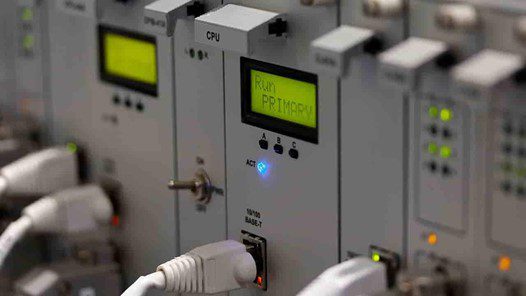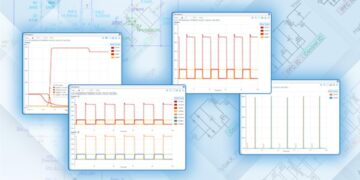
Some in the industry have called industrial IoT and Industry 4.0 a pipe dream. In reality, newer components and compute platforms for embedded systems are making connected factories a reality in ways we could not imagine just a few years ago. Today’s factories have more compute power than ever before, and there is no sign of this trend changing anytime soon. In addition to compute power, industrial systems designers need their products to occupy smaller packages with more features on a single chip as well as enable real-time connectivity in high-throughput manufacturing environments.
To meet the demand for lightweight and heavyweight processor solutions targeting the industrial IoT space, Texas Instruments offers two rugged processors for industrial applications: the Sitara™ AM6442 processor and AM2434 MCU. The TI AM6442 processor meets these requirements with a feature set that specifically targets the industrial IoT space. For lightweight computing and data capture at endpoints, the AM2434 MCU competes well with the AM6442 processor in terms of I/O count, processing speed, integrated bus interfaces, and much more.
Processing Requirements for Industrial IoT

Not all industrial IoT systems require the level of computing you might find in a data center or even a personal computer. For example, some lightweight vision and robotics tasks can be performed using an MCU with less compute than an SBC. Other tasks include fusing data from multiple sensors, performing some basic calculations or analysis, and transmitting elsewhere on an industrial network.
Although these tasks don’t require high compute or a dedicated computer, they do require low-latency processing, network connectivity, and the ability to interface with a variety of peripherals over standard digital interfaces or an analog front-end. The processing and compute requirements in today’s industrial IoT systems target data capture and transmission to an external system (e.g., a cloud service) for further processing and analysis.
When we look at the processing requirements for these systems, we can narrow down to a particular feature set that is desirable in processors for industrial IoT platforms:
- High GPIO count
- Moderate resolution ADC
- Integrated Ethernet switch for network communications
- Digital bus interfaces for on-board peripherals and digital sensors
- Parallel bus interface for accessing legacy equipment
- Integrated memory with access to additional DDR or Flash as needed
- Industrial-level safety certification
The new Sitara™ TI AM6442 processor and AM2434 MCUs satisfy these requirements to provide a single-processor solution for embedded systems in industrial settings. Let’s look at the important specifications for each component to see where these components are best used.
TI AM6442 Processor Specifications
The Sitara™ AM6442 processor supports a Linux/RTOS kernel in a high-pin-count package. This component is intended to act as the host processor for a lightweight embedded system like an industrial computer.
| CPU cores | Dual-core ARM® Cortex® A53 (64 bit) and R5F (64 bit) |
| Max clock | 0.8 GHz/1.0 GHz |
| GPIO count | Up to 198 |
| Low-speed interfaces | GPMC, I2C, UART, Multichannel SPI |
| High-speed interfaces | PCIe 2.0, DDR subsystem (up to LPDDR4), USB 3 |
| Analog interface | Multichannel 12-bit ADC (Up to 4 MSPS) |
| Ethernet | Up to 5x gigabit Ethernet ports (RGMII) with external PHY, support for IEEE 1588 precision clock synchronization, Up to 12 Mbps PROFIBUS, PROFINET, EtherNet/IP, EtherCAT, and TSN |
| Boot options | Boots via UART, I2C, Flash (OSPI//QSPI/SPI/parallel NOR) parallel NAND Flash, SD, eMMC, USB 2.0, PCIe,
and Ethernet interfaces |
| Safety qualification | TI provides documentation to aid IEC 61508 functional safety system design |
There are two points in the above list that are quite important for industrial systems: IEEE 1588 and IEC 61508. The IEEE 1588 standard is commonly used in applications requiring precision timing between networked equipment in a variety of settings, including data centers, manufacturing, automotive, robotics, and even high-speed trading in financial institutions. This clock distribution standard ensures data transmission over Ethernet remains synchronized throughout a manufacturing environment to ensure the precise timing and processing of data.
The IEC 61508 standards conformance is an important part of working in industrial settings, where hazard and risk analysis are performed to ensure hazard exposure is minimized. Texas Instruments intends to provide the necessary documentation to help industrial electronics designers and facilities engineers prepare risk assessments and compliance reports, something that is unique among MPU vendors.
TI AM2434 MCU Specifications
The Sitara™ AM2434 MCUs are compatible with Texas Instruments developer tools, where firmware is compiled to a binary and flashed directly onto the device. The specifications for this component are very similar to the AM6442 processor; the table below shows the primary differences for comparison.
| CPU cores | Up to quad-core ARM Cortex R5F (64 bit) |
| Max clock | 0.8 GHz |
| Analog interface | Multichannel 14-bit ADC (Up to 4 MSPS) |
| Ethernet | Up to 5x gigabit Ethernet ports (RGMII), support for IEEE 1588 precision clock synchronization, Up to 12 Mbps PROFIBUS, PROFINET, EtherNet/IP, EtherCAT, and TSN |
The major advantage of this component is in firmware development. The AM2434 MCU allows everything to be compiled to a binary and flashed directly to the chip or an external memory device with a flashing utility and adapter. Make sure you check the requirements for internal versus external memory when selecting components, as you might need an external Flash chip to boot your application and store data.
Power Consumption
Both the AM2434 MCU and AM6442 platforms have low power consumption (approximately ~2 W maximum) during operation. With both components’ relatively low junction-to-free-air thermal resistance values, designers can expect temperature rises of only approximately 20 °C. These components could be used in a small package with a fanless enclosure, assuming no other components or circuits on the board generate large amounts of heat. In other cases, a small heatsink is usually sufficient to provide enough cooling to keep these components within a safe temperature range.
A Streamlined Platform for Industrial IoT
The AM2434 MCU and AM6442 platform provides a streamlined option for industrial IoT systems. These components include high-speed interfaces that would normally require a bridge or interface converter when other popular MCUs are used, but in a less expensive and compact package. Although the package is more highly integrated, embedded developers should already be familiar with the tools needed to get started developing for these platforms.
The AM6442 processor has the potential to place embedded industrial computing into a smaller platform in applications requiring highly precise timing thanks to the integrated IEEE 1588 clock distribution protocol. Meanwhile, the AM2434 MCU can function as a lightweight endpoint with much greater compute than most other MCUs on the market. These components can address every point in the embedded industrial ecosystem with a targeted solution.
When you need to find PCB footprints, technical data, and sourcing information for embedded processors like the TI AM6442 processor and AM2434 MCU, look to the electronics search engine features in Ultra Librarian. Ultra Librarian allows you to find new components for your system and a range of reference designs from popular manufacturers. All ECAD data you’ll find on Ultra Librarian is compatible with popular ECAD applications and is verified by component manufacturers to help you streamline your design process.
Working with Ultra Librarian sets up your team for success to ensure streamlined and error-free design, production, and sourcing. Register today for free.








